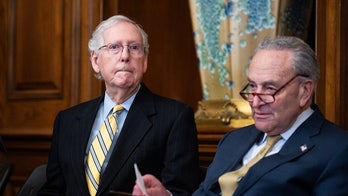Trump took the political debate out of Congress, put it on live TV: Varney
FBN's Stuart Varney on how President Trump has changed the political process in Washington, D.C.
Lawmakers walking out of President Trump’s live, televised roundtable on guns last week weren’t quite sure what to make of it.
Senate Majority Whip John Cornyn, R-Texas, characterized it as “fascinating television.”
Sen. Chris Murphy, D-Conn., described it as “reality TV.”
The hour-long diorama played out live on cable news channels with Trump parrying the thrusts of members of Congress. The president declared drastic policy shifts from the typical GOP stance on firearms, while stage directing the whole session.
Trump coaxed positive words out of Democrats like California Sen. Dianne Feinstein, a Democrat. And he openly disputed and argued points made by such Republicans as House Majority Whip Steve Scalise, of Louisiana; Rep. John Rutherford, of Florida; and Sen. Pat Toomey, of Pennsylvania.
We’ve seen such a pageant before. Trump is the quintessential virtuoso. Look at his old TV show “The Apprentice.” He was made for these forums, nimbly presiding over the meeting at a large table at the White House, doubling as a board room full of voting shareholders.
Trump knows when the red light atop the camera switches on. Still, it remains to be seen whether anything of substance will come of the most recent confab. Granted, just today, the Trump administration moved to prohibit bump stocks, which essentially allow a rifle to rapid-fire bullets.
But recall back in January when the president convened a similar summit on DACA, the Obama-era immigration program formally known as the Deferred Action for Childhood Arrivals.
Democrats and Republicans alike left the White house thinking they were on the road to a compromise and would grant official status to millions of undocumented persons. Then the president reversed course, scuttling hope of an agreement.
Everyone may presume that Trump’s old TV show is the prototype for these televised discussions. But we’ve seen presidents deploy this technique before to sway the public, using television. Trump’s boardroom assemblies are just one variant of contorting the administration’s message and marketing the chief executive.
The press often complains that it lacks sufficient “access” to policymakers. It rarely gets to observe and document negotiations in the “smoke filled room” where leaders forge deals and make decisions.
Hedrick Smith is the author of “The Power Game,” a magnum opus chronicling the folkways and political mechanics that make Washington, D.C., tick. Smith writes of how White House operators engage in “media jujitsu.”
A principle in the martial art jujitsu is turning the power of your adversary against them. Pictures and live video are the strengths of the modern press corps. So, the key for any administration is to flip that asset against the media to contour the narrative.
“The visual beats the verbal,” Smith writes. “The eye predominates over the ear; sight beats sound.”
Smith recounts a now-legendary Washington story involving CBS News White House Correspondent Lesley Stahl and her coverage of the Reagan administration.
In early October 1984. Reagan faced former Vice President Walter Mondale for re-election in a little more than a month. Stahl drafted a tough piece about Reagan’s use of television. She argued that the Reagan White House used TV “to create visual amnesia” about the president’s perceived achievements and policies.
The script for Stahl’s TV report detailed how Reagan slashed funding for the disabled, cut money for subsidized housing for the elderly and ducked tough questions about a military mess in Lebanon by escaping to his California ranch. All were harsh but fair criticisms of the president.
But the visuals Stahl used told a different story. “Reagan cutting the ribbon at an old-folks home; greeting handicapped athletes in wheelchairs; giving a hug to Olympic gold-medal winner Mary Lou Retton; touring a cave saved by an environmental project; receiving a birthday cake and a kiss from Nancy,” Smith wrote.
Stahl described her TV package as “the single toughest piece I had ever done on Reagan.”
She braced for an earful from the White House.
The story aired. A senior official promptly phoned Stahl.
“Great piece,” the official told her. “You’re showing four and a half minutes of great pictures of Ronald Reagan, no one listens to what you say. Don’t you know that the pictures are overriding your message because they conflict with your message?”
Stahl was floored.
Fast-forward to present day.
It doesn’t matter much what Trump does or says at these conclaves with lawmakers. The outcome may not matter. What’s crucial is how the president looks.
He appears presidential. In control. A business executive running an efficient meeting. Bringing stakeholders from all sides to the table. Listening and giving credence to those who appear to disagree with the conventional GOP position on DACA or guns. Challenging members of his own party.
The networks take it live. The jujitsu is at work. And it’s immaterial as to whether anything is ever accomplished on DACA or firearms. As Hedrick Smith argues, the visual beats the verbal.
Trump looks like he’s charge and has a steady hand on the tiller. Therefore, the public interprets that he’s in charge and has a steady hand on the tiller. The casual observer views that the president is accomplishing things and addressing problems. The visual emerges triumphant every time, regardless of the facts.
This isn’t something new to the Trump White House. All administrations engage in some form of this.
One wonders if there is a limited shelf-life to these televised tete-a-tetes with members of Congress. Trump has now conducted two such meetings this year on major, intractable issues.
Will lawmakers cease attending such symposiums because they don’t solve anything? Will members of Congress decline invitations to head to the White House? Will they realize they’re little more than extras or spear carriers, playing a role in the stagecraft of President Trump?
Unlikely.
Members of Congress of both parties have the same political needs as the president. They need the public to embrace them. What better way to accomplish that than to be invited to the White House with the most powerful person on the planet for an opportunity to address a pressing issue?
This goes for hard-right conservatives who represent Trump country and would love to score a few frames with the president. That’s good politics back home. It also works for hard-left Democrats who are diametrically opposed to Trump.
They represent constituents which may throw a brick at the TV if the president appears on their screen. But this is an opportunity for those Democrats. The visual portrays the Democrats as “being reasonable” and willing to talk with an opponent to find a solution to a challenging problem.
A fix to DACA seems elusive. The same with guns. Nothing may ever change.
But the pictures say otherwise. They look like they’re trying.





